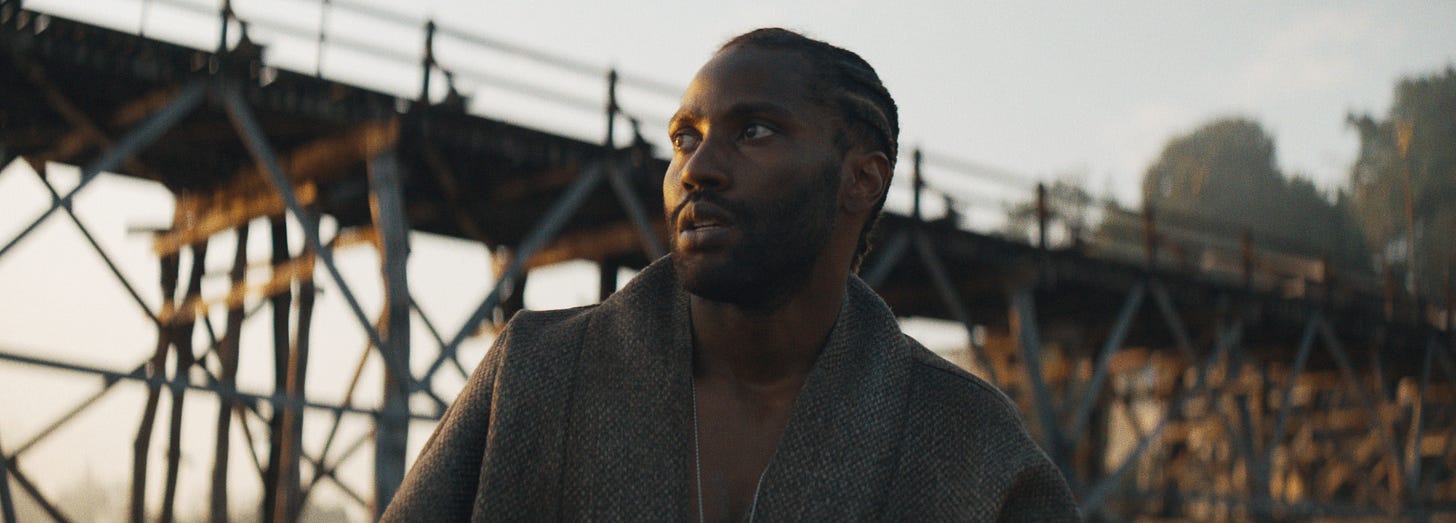The Creator
Humanity grapples with its relationship to the artificial intelligence it made.
★★☆☆
Several decades into the future, humanity is at war with AI, hunting down “simulants” (AI in robotic bodies) and the people who harbor them across the globe. Joshua (John David Washington) is an ex-special forces soldier tasked with finding the Creator, the mind behind the AI. Five years after a failed mission, he’s sent back into the field to chase down a lead to the Creator’s newest weapon … which turns out to be another simulant in the form of a child (Madeleine Yuna Voyles).
The inherent personhood of AI is never up for debate. The Creator is not about discovering that Robots Are People Too; the fact that simulants are conscious, independent beings is established from the opening frames of the film and is used as justification to wage war on them. The Creator is more Zero Dark Thirty than Blade Runner, tracing Joshua’s emotional arc as he grapples with his role in the war on simulants. The film telegraphs its sympathies early on: as the bodies of simulants are destroyed in a trash compactor, one appears to try to climb out of the heap before it, too, is crushed. When soldiers touch down in a village in Southeast Asia to search for information, they’re flanked by flying backup that recalls the helicopters in Platoon. Joshua watches, silent, as his fellow soldiers question the villagers with surgical, callous disregard.
As an actor, Washington is a guarded screen presence. This makes him a good leading man in films about extraordinary situations where the protagonist needs to keep his feelings close to his chest, such as Tenet and BlacKkKlansman. As Joshua, Washington here has to play a soldier under deep cover. The emotional thrust of the film is not the war but Joshua’s conflict about his role in labeling AI as a kind of monstrous Other. His internal struggle is not served by the film’s plot-forward approach, which is made heavy-handed by its action sequences and its handling of the robotic characters.
The Creator isn’t interested in exploring the personhood of AI, though it does make a few obligatory feints toward the topic. Soldiers repeat to each other that the AI they kill are only being “switched off” and that their emotional outcries are “just programming.” But the film, in contrast to the soldiers’ beliefs, presents simulants as people who happen to not be human. Early models are large and metallic; later models wear human faces but have massive holes at the base of their skulls that expose the inner workings of their heads where a human cerebellum would be. The hole-in-the-head imagery is beautifully unsettling, making simulants both instantly recognizable and unlike any other cyborg/android presence on screen. I have questions about the inherent design flaw of permanently exposing a robot’s brain to debris and contamination, but The Creator is soft science fiction, more focused on addressing philosophical questions with futuristic aesthetics than explaining how it all works, as its hard-science counterparts would. The film is more interested in plot than logistics.
And the plot of the movie is rapid-fire, swiftly skipping from place to place and conflict to conflict. Some of the leaps are efficient; others feel perfunctory. The worst sequences explain the film’s terms in the plainest manner possible, leaving the characters no time to breathe. The best sequences rely on Edwards’s knack for images that convey a sense of mystery, dread, and scale; one of the most striking repeated images is of a massive airship haunting the sky like a malevolent hovering gull. Most of the action takes place in the jungles and cities of Southeast Asia, with the vertical, domed mountains of northern Thailand and Vietnam blending seamlessly with the smooth curves of the futuristic temples and buildings in which Joshua finds himself. Edwards worked on the Star Wars prequel Rogue One, a creative pedigree that’s stamped directly into the ovoid shapes of the sets and androids that populate the movie. The film looks very much like a Star Wars movie, albeit with heavier questions on its mind than the typical good-versus-evil binary that drives the stories of the galaxy far, far away.
The Creator fails to answer those questions in a satisfying way. Instead, it falls into the trap of the worst Star Wars movies: leaning on Orientalism as an aesthetic shorthand and boiling its conflicts down into something that can be resolved, once and for all, in a big battle. There’s no specificity in the film’s setting, despite the striking mountains in the background and despite the fact that the film purposefully draws on imagery borrowed from Vietnam War movies and from Kurosawa to make a point. The Creator spends most of its time in “New Asia,” a fictionalized conglomerate that flattens Nepalese, Indian, Thai, Cambodian, Japanese, and Vietnamese cultures into a kind of shapeless mass. For a movie so preoccupied with the consequences of forcing conscious beings into the role of a monstrous Other, The Creator is curiously uninterested in developing its own world into something richer and more complex than the arc of a standard epic action movie. I wish the film had been more willing to reject the box it came in. —Sarah Welch-Larson
The Creator is in theaters everywhere.




I thoroughly enjoyed the movie, but agree with you about the missed opportunities regarding the script. It could have been a great philosophical classic, but fell short